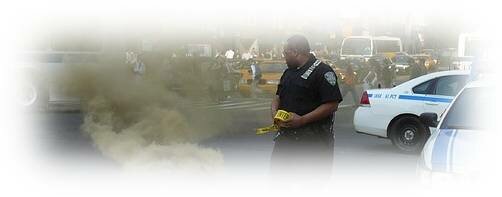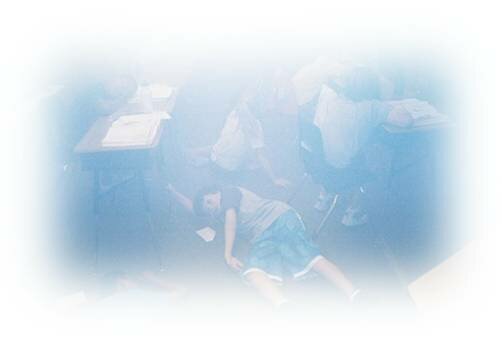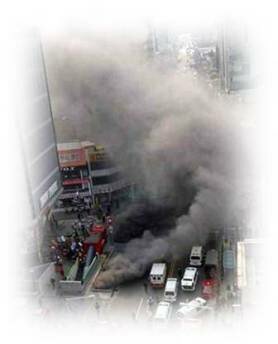Histotoxic Hypoxia

Histotoxic Hypoxia develops when body is getting enough oxygen, but it cannot use it sufficiently due to physiological problems at a cellular level.
Thus due to a disruption of oxidative phosphorylation enzymes activity, tissue cells are unable to use the oxygen effectively.
Excessive drinking of alcohol or narcotics, can also produce such physiological effect.
In other cases histotoxic hypoxia can be developed by a person exposed to poisoning chemicals or gases in poorly ventilated or insufficiently controlled areas.
In such cases hemoglobin’s abilities to bind, transport and release oxygen are inhibited by poisoning gas. The examples of such cause of histotoxic hypoxia are Carbon Monoxide Poisoning, Cyanide Poisoning, Poison Gas attack or other toxic chemicals.

The injuries caused by carbon monoxide (CO) traditionally have been viewed as due to a hypoxic stress mediated by an elevated carboxyhemoglobin (COHb) level. The two organ systems most susceptible to injury from CO are the cardiovascular and central nervous systems. Human and animal data indicate that major cardiac injury is due primarily to CO-induced hypoxic stress.
Representing only 2-3% of an adult’s body mass, the brain receives 20% of the cardiac output and accounts for about one fourth of overall resting oxygen consumption. The brain is one of the most oxygen-sensitive organs of the body, and it is not surprising that neurologic dysfunction is a prominent manifestation of hypoxia.260
Cerebral vascular resistance is prominently affected by acute hypoxia and increases when PaO2 falls below 50-60 mm Hg. However, with continued hypoxia, adaptation occurs, and overall cerebral blood flow in hypoxemic patients with COPD is normal. The brain is very sensitive to changes in perfusion, and effects of hypoxia on the brain are more likely to be due to decreased perfusion than to hypoxemia.260

Photo courtesy of Kyle Kesselring
Methylene chloride is another toxic component presented in a solutioins like paint thinners. It is converted to CO by the cytochrome P-450 after it enters the liver. Endogenously created CO derived from methylene chloride has a much longer half life than exogenously inhaled CO, but the symptoms are similar. CO poisoning should be suspected in persons who exhibit toxicity after using paint thinning products in a closed environment.
Another increasingly more common source of CO is propane-powered motors such as those found in warehouse fork lifts and ndustrial floor buffers. Ideally, these propane engines should burn cleanly if properly maintained. However, a poorly maintained propane engine will emit nearly as much CO as an internal combustion (gasoline) engine.

Since 1960, the clinical use of HBO2 for CO poisoning has occurred with increasing frequency. Over 2,500 CO-intoxicated patients were treated in North American hyperbaric chambers in 1992. However, this is only a small fraction of those poisoned with CO. Extrapolation of data from a 1994 survey across three western states projected that over 4,000 CO-poisoned patients are evaluated in emergency departments annually in the United States.
Hyperbaric oxygen (HBO2) significantly increases the oxygen diffusion driving force, thus increasing oxygen availability to tissues. This helps to correct negative effects of histotoxic hypoxia and restore normal tissue oxygenation.
In reported series, clinical recovery among patients treated with HBO2 appears to be improved beyond that expected with ambient pressure supplemental oxygen therapy. This has been observed both in terms of mortality and neurologic morbidity. This research found that the optimal benefit from HBO2 occurs in those treated with the delay after exposure and that repeat treatments may yield a better outcome than just a single treatment in selected patients.121
If you prefer to learn more about Hypoxia by reading a well written textbook, we recommend a selection of best books from Amazon.com. Providing a detail overview of hypoxia, hypoxia symptoms and types, the recommended books address the distinctive problems that hypoxia presents to vulnerable organs such as the kidney, liver, heart and brain.

Further Reading...
-
-
-
- Hyperbaric Oxygen Treatment : The Last Frontier. Philip B James MB ChB, PhD, DIH, FFOM
- Treatment of Diabetic Ulcer Wounds By Hyperbaric Oxygenation. Review Of Scientific Trials Concerning Diabetic Foot Ulcers
- Retinopathy of prematurity may be prevented by the intermittent use of higher dosages of oxygen.
- Hyperbaric Oxygen Treatment (HBOT): oxygen transport to ischemic / hypoxic tissues is explained in this article by analyzing the physics and physiology of oxygen.
- Why Hyperbaric Oxygen Therapy is the most natural way of letting the body to heal itself...
- Aerobic Cellular Respiration Overview...
- TRCS - Transportable Recompression Chamber System For Emergency Evacuation And Treatment.
- Acute Brain and Cardio-Respiratory Dysfunction After Blast/Blunt Injuries: The Life-Preserving Effects of Hyperbaric Oxygenation...
- Diseases of the Respiratory System.
- Oxygen Toxicity Overview
- Characteristics for Autism Spectrum Disorders and diagnostic criteria.
- Near Drowning Overview.
- HBOT: historical perspective and physical basis...
- Hypoxia is sometimes dangerous, life-threatening state for our cells and tissues. Learn about hypoxia symptoms, causes and types...
- SPECT - Single Photon Emission Computed Tomography Emission Computed Tomography, a type of nuclear imaging showing how blood flows to tissues of organs.
- Air Embolism, the definitive treatment of which remains Hyperbaric Oxygen Therapy (HBOT).
- Carbon Monoxide Poisoning, recovery among patients treated with Hyperbaric Oxygen appears to be improved beyond that expected with ambient pressure supplemental oxygen therapy...
- Cyanide poisoning in combination with carbon monoxide poisoning frequently occur simultaneously in victims of fires, smoke inhalation, military operations and industrial accidents.
- For Gas Gangrene (Clostridial Myonecrosis) and Clostridial Myositis or spreading clostridial cellulitis with systemic toxicity the preferred treatment is a combination of Hyperbaric Oxygen Therapy (HBOT), Surgery, and Antibiotics.
- Crush injury is directly associated with trauma while skeletal muscle compartment syndromes arise from ischemia, venous outflow obstruction, exertion, external compression as well as trauma.
- Hyperbaric Oxygen Treatment Center At Elisha & Rambam Hospitals
- With Compartment Syndrome, Hyperbaric Oxygen Therapy (HBOT) when used as an adjunct to a surgery and antibiotics shows promise as a way to decrease complications and morbidity.
- Decompression Sickness - definition, symptoms and treatment of choice...
- Non healing wounds like diabetic foot ulcers can benefit from HBOT.
- Exceptional Blood Loss Anemia and Hyperbaric Oxygen Therapy (HBOT) as adjunctive therapy to win the time for survaval...
- Subdural empyema and other intracranial or cerebral abscesses are usually caused by anaerobic bacteria (bacteria that function optimally in low oxygen concentrations)...
- Necrotizing wound infection may result from either a single strain or a mixed population of bacteria, typically occurring after trauma, surgery, and/or around foreign bodies...
- Refractory osteomyelitis is a chronic osteomyelitis which often does not responded to the treatment administrated. HBOT directly kills or inhibits the growth of infection also augmenting the efficacy of bacterial killing by antibiotics.
- Tissue necrosis, bone necrosis and other radiation injuries as a delayed complications of radiation exposure...
- Skin graft survive when oxygen and nutrients diffuse into them from the underlying wound bed...
- Thermal Burns: HBOT when used as an adjunct in a comprehensive program of burn care, can significantly improve morbidity and mortality, reduce length of hospital stay, and lessen the need for surgery.
- The appearance of early symptoms of autism is a reason to have a child evaluated by a professional specializing in Autism Spectrum Disorders. See the autism symptoms checklist...
- Several autism types have been defined along the autism spectrum, differing in the severity of the symptoms and total disability and in the combinations of autistic impairments with other disabilities.
- Autism And Vaccinations: Clear Answers & Smart Advice About Your Baby’s Shots
- Portable Hyperbaric Chambers and HBOT should become an important player in humanitarian efforts in support of casualties sustained by individuals from natural disasters, battlefields and terrorist acts...
- Portable Hyperbaric Chambers SOS Hyperlite
- In spite of a number of existing Autism treatments, there are no miracle autism cures. For many realistic parents striving to help their autistic kids to feel less frustrated, communicate, perform and feel better, one of the crucial questions is what is the correct course of the autism treatment?















